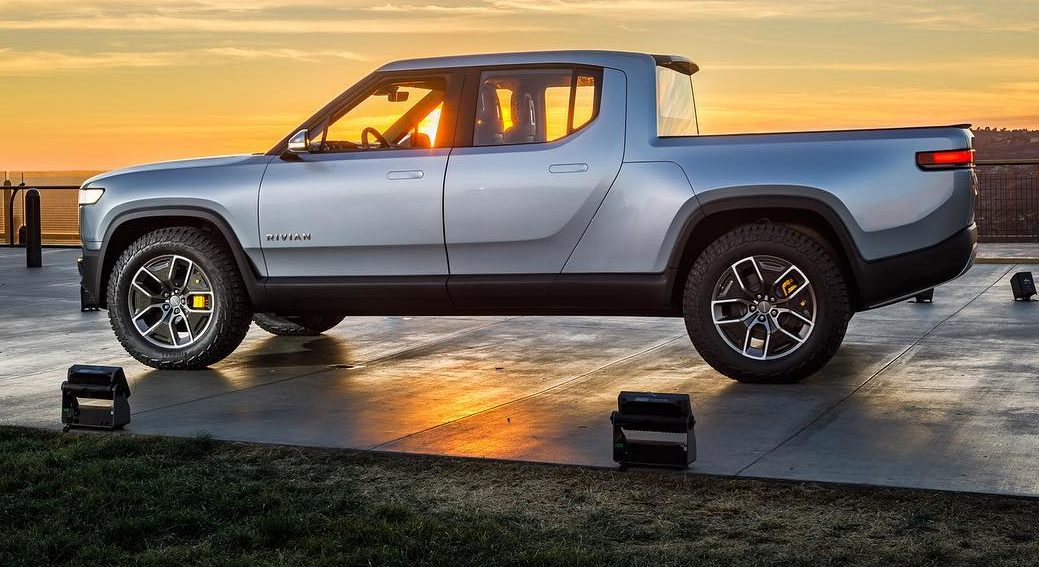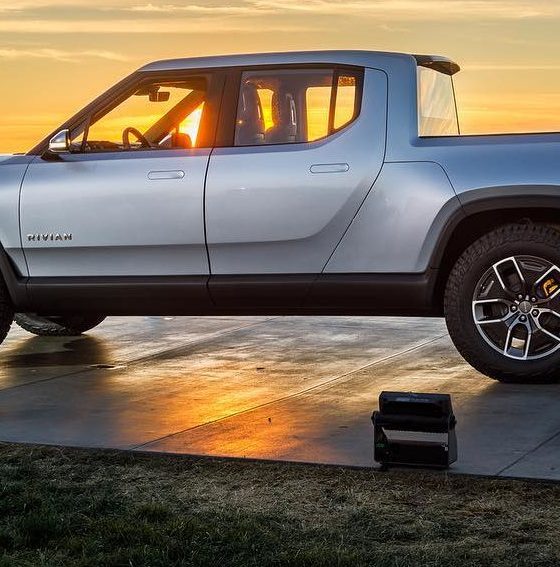Rivian is attending Amazon’s re:MARS 2019 event this week, an information and networking conference sponsored by the online retail giant focused on artificial intelligence (AI), robotics, and other related Earth and space technologies, including self-driving.
The latest research, scientific advancements, and industry innovations are shared during four-days of networking, keynotes, and information sessions, and speakers from companies such as Walt Disney Imagineering and NASA’s Jet Propulsion Laboratory are on the schedule. The event takes place from June 4-7 at the Aria Resort & Casino in Las Vegas, Nevada.
The Amazon re:MARS Twitter account posted a tweet announcing Rivian’s appearance, which was then retweeted by CEO RJ Scaringe. “What happens when you combine a thirst for adventure with automotive tech and AI? Meet the world’s first Electric Adventure Vehicle at #reMARS to find out,” it said. The tweet was also tagged with “#alexaauto”, possibly indicating Rivian’s inclusion of Amazon’s Alexa voice assistant in its upcoming R1T truck and R1S SUV. Another electric car maker has already opted for this route – China’s Byton has Alexa integrated into its vehicle operating system.
What happens when you combine a thirst for adventure with automotive tech and AI? Meet the world’s first Electric Adventure Vehicle at #reMARS to find out: https://t.co/41ICnYmPNN #alexaauto @Rivian pic.twitter.com/gRG2kZh3mI
— Amazon re:MARS (@AmazonreMARS) June 2, 2019
re:MARS stands for Machine Learning, Automation, Robotics, and Space, and the event is described on its website as follows:
“re:MARS brings together innovative minds with diverse skill sets who share an inventors spirit, a builders mentality, and a desire to use AI to initiate change and shape the future. The event is designed for business leaders and technical builders (including developers, engineers, data scientists, ML [machine learning] experts, and roboticists) who translate customer problems into real-world technology solutions using AI.”
Given re:MARS’s description, Rivian’s plans for including self-driving in its R1T and R1S make its presence particularly relevant to the focus of the event. The camera and radar hardware on Rivian’s production vehicles will be capable of Level 3 autonomous driving that’s upgradable via over-the-air software updates. The initial vehicles will ship with Level 2 capabilities and use data accumulated from its customers’ driving sent to the cloud to develop its Level 3 transition.
Amazon has also invested heavily into Aurora, a self-driving startup led by ex-Tesla and ex-Google executives, and an information session hosted by the company as part of the re:MARS event. Rivian’s self-driving plans could possibly cross over with Aurora’s autonomy developments as both companies share an Amazon business linkage. The description of the Aurora information session is as follows:
“The Future of Self-Driving Technology: Aurora is improving self-driving technology with the Aurora Driver, the computer system that powers and coordinates signals from its perception system to control vehicles of different makes, models and classes. Hear from Aurora to better understand the role of AI in self-driving technology and the longstanding impacts of self-driving cars for our future.”
A map of re:MARS’s tech showcase location shows Rivian mingled with Alexa & iRobot | Smart Home, and Cybic, an electric bike company using Amazon’s Alexa digital assistant.

Amazon’s $700 million dollar investment into Rivian also likely plays a part in Rivian’s appearance at re:MARS. CEO Jeff Bezos recently referred to the electric car industry as “fascinating” and said he was excited to participate in its developments along with vehicle connectivity. Specifically referring to Rivian, he complimented Scaringe, saying he’s “one of the most missionary entrepreneurs I’ve ever met.”
RJ Scaringe has made reference to Rivian’s vehicles hosting self-guided tours fashioned like those seen in the classic 90s movie Jurassic Park. Given Amazon’s investment in the all-electric startup and the car maker’s subsequent appearance at an Alexa-focused event, perhaps the Rivian AI tour guide won’t be modeled after a classic Hollywood actor and narrator after all, an idea which was admittedly driven by imagination to begin with. “The voice you’re now hearing is Richard Kiley. Heh, we’ve spared no expense!” Richard Hammond, the fictional owner of Jurassic Park, exclaims in the movie while the tour group advanced through the dinosaur exhibits. Alexa, take me to the Tyrannosaurus rex, anyone?
While Rivian’s presence at Amazon’s re:MARS event hasn’t yet produced many details to confirm any speculations, it’s at the very least a nod towards the company’s exciting, technology-driven future.

Elon Musk
Starlink passes 9 million active customers just weeks after hitting 8 million
The milestone highlights the accelerating growth of Starlink, which has now been adding over 20,000 new users per day.

SpaceX’s Starlink satellite internet service has continued its rapid global expansion, surpassing 9 million active customers just weeks after crossing the 8 million mark.
The milestone highlights the accelerating growth of Starlink, which has now been adding over 20,000 new users per day.
9 million customers
In a post on X, SpaceX stated that Starlink now serves over 9 million active users across 155 countries, territories, and markets. The company reached 8 million customers in early November, meaning it added roughly 1 million subscribers in under seven weeks, or about 21,275 new users on average per day.
“Starlink is connecting more than 9M active customers with high-speed internet across 155 countries, territories, and many other markets,” Starlink wrote in a post on its official X account. SpaceX President Gwynne Shotwell also celebrated the milestone on X. “A huge thank you to all of our customers and congrats to the Starlink team for such an incredible product,” she wrote.
That growth rate reflects both rising demand for broadband in underserved regions and Starlink’s expanding satellite constellation, which now includes more than 9,000 low-Earth-orbit satellites designed to deliver high-speed, low-latency internet worldwide.
Starlink’s momentum
Starlink’s momentum has been building up. SpaceX reported 4.6 million Starlink customers in December 2024, followed by 7 million by August 2025, and 8 million customers in November. Independent data also suggests Starlink usage is rising sharply, with Cloudflare reporting that global web traffic from Starlink users more than doubled in 2025, as noted in an Insider report.
Starlink’s momentum is increasingly tied to SpaceX’s broader financial outlook. Elon Musk has said the satellite network is “by far” the company’s largest revenue driver, and reports suggest SpaceX may be positioning itself for an initial public offering as soon as next year, with valuations estimated as high as $1.5 trillion. Musk has also suggested in the past that Starlink could have its own IPO in the future.
News
NVIDIA Director of Robotics: Tesla FSD v14 is the first AI to pass the “Physical Turing Test”
After testing FSD v14, Fan stated that his experience with FSD felt magical at first, but it soon started to feel like a routine.

NVIDIA Director of Robotics Jim Fan has praised Tesla’s Full Self-Driving (Supervised) v14 as the first AI to pass what he described as a “Physical Turing Test.”
After testing FSD v14, Fan stated that his experience with FSD felt magical at first, but it soon started to feel like a routine. And just like smartphones today, removing it now would “actively hurt.”
Jim Fan’s hands-on FSD v14 impressions
Fan, a leading researcher in embodied AI who is currently solving Physical AI at NVIDIA and spearheading the company’s Project GR00T initiative, noted that he actually was late to the Tesla game. He was, however, one of the first to try out FSD v14.
“I was very late to own a Tesla but among the earliest to try out FSD v14. It’s perhaps the first time I experience an AI that passes the Physical Turing Test: after a long day at work, you press a button, lay back, and couldn’t tell if a neural net or a human drove you home,” Fan wrote in a post on X.
Fan added: “Despite knowing exactly how robot learning works, I still find it magical watching the steering wheel turn by itself. First it feels surreal, next it becomes routine. Then, like the smartphone, taking it away actively hurts. This is how humanity gets rewired and glued to god-like technologies.”
The Physical Turing Test
The original Turing Test was conceived by Alan Turing in 1950, and it was aimed at determining if a machine could exhibit behavior that is equivalent to or indistinguishable from a human. By focusing on text-based conversations, the original Turing Test set a high bar for natural language processing and machine learning.
This test has been passed by today’s large language models. However, the capability to converse in a humanlike manner is a completely different challenge from performing real-world problem-solving or physical interactions. Thus, Fan introduced the Physical Turing Test, which challenges AI systems to demonstrate intelligence through physical actions.
Based on Fan’s comments, Tesla has demonstrated these intelligent physical actions with FSD v14. Elon Musk agreed with the NVIDIA executive, stating in a post on X that with FSD v14, “you can sense the sentience maturing.” Musk also praised Tesla AI, calling it the best “real-world AI” today.
News
Tesla AI team burns the Christmas midnight oil by releasing FSD v14.2.2.1
The update was released just a day after FSD v14.2.2 started rolling out to customers.

Tesla is burning the midnight oil this Christmas, with the Tesla AI team quietly rolling out Full Self-Driving (Supervised) v14.2.2.1 just a day after FSD v14.2.2 started rolling out to customers.
Tesla owner shares insights on FSD v14.2.2.1
Longtime Tesla owner and FSD tester @BLKMDL3 shared some insights following several drives with FSD v14.2.2.1 in rainy Los Angeles conditions with standing water and faded lane lines. He reported zero steering hesitation or stutter, confident lane changes, and maneuvers executed with precision that evoked the performance of Tesla’s driverless Robotaxis in Austin.
Parking performance impressed, with most spots nailed perfectly, including tight, sharp turns, in single attempts without shaky steering. One minor offset happened only due to another vehicle that was parked over the line, which FSD accommodated by a few extra inches. In rain that typically erases road markings, FSD visualized lanes and turn lines better than humans, positioning itself flawlessly when entering new streets as well.
“Took it up a dark, wet, and twisty canyon road up and down the hill tonight and it went very well as to be expected. Stayed centered in the lane, kept speed well and gives a confidence inspiring steering feel where it handles these curvy roads better than the majority of human drivers,” the Tesla owner wrote in a post on X.
Tesla’s FSD v14.2.2 update
Just a day before FSD v14.2.2.1’s release, Tesla rolled out FSD v14.2.2, which was focused on smoother real-world performance, better obstacle awareness, and precise end-of-trip routing. According to the update’s release notes, FSD v14.2.2 upgrades the vision encoder neural network with higher resolution features, enhancing detection of emergency vehicles, road obstacles, and human gestures.
New Arrival Options also allowed users to select preferred drop-off styles, such as Parking Lot, Street, Driveway, Parking Garage, or Curbside, with the navigation pin automatically adjusting to the ideal spot. Other refinements include pulling over for emergency vehicles, real-time vision-based detours for blocked roads, improved gate and debris handling, and Speed Profiles for customized driving styles.










